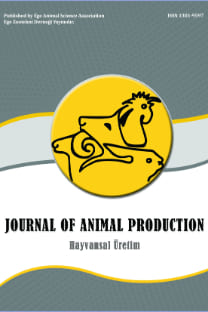On-farm Management, Breeding Practice and Constraints Between Two Sheep Breeds in Bangladesh
Sheep Production, Management, Breeding Practice, Constraints
___
- Ahmed, S., Rakib, M. R. H., Yesmin, M., Sultana, N., Jahan, N., & Ershaduzamman M. (2018). Evaluation of lamb production potentiality of the Barind, Jamuna river basin and coastal region sheep of Bangladesh under intensive management. Journal of Advanced Veterinary and Animal Research, 5(1):37- 43.
- Banerjee, G.C. (1989). A Text Book of Animal Husbandry. 6th Edn., Oxford and IBH Publishing Co. Pvt. Ltd., New Delhi.
- ISSN: 1301-9597
- Yayın Aralığı: 2
- Başlangıç: 1974
- Yayıncı: EGE ZOOTEKNİ DERNEĞİ
Çankırı İlinde Yetiştirilen Akkaraman Irkı Kuzuların Büyüme Özelliklerinin Belirlenmesi
Çağrı Melikşah SAKAR, İlker ÜNAL
Süt Sığırcılığı İşletmelerinde Ayak Banyosu Uygulamaları
Mehmet KOYUNCU, İlkay ÇETİN, Halim Gökhan SARGIN, Erdem ÇETİN
Effects of Some Vitamin, Mineral, Esantial Oils Used in Animal Nutrition on Meat Quality
Sibel SOYCAN ÖNENÇ, Mürsel ÖZDOĞAN
Bursa İli Mustafakemalpaşa İlçesi Manda Yetiştiriciliği "Karaoğlan Mahallesi Örneği"
Mehmet KOYUNCU, İlkay ÇETİN, Halim Gökhan SARGIN, Erdem ÇETİN
Evaluating the sustainability of egg production in Turkey: A standardized data approach
Neslihan KALKAN, Servet YALÇIN
On-farm Management, Breeding Practice and Constraints Between Two Sheep Breeds in Bangladesh
Mohammad ASADUZZAMAN, Mgs Golam ALAM, Pankaj Kumar JHA, Farida BARİ
Hayvan beslemede kullanılan bazı vitamin, mineral ve uçucu yağların et kalitesine etkileri
